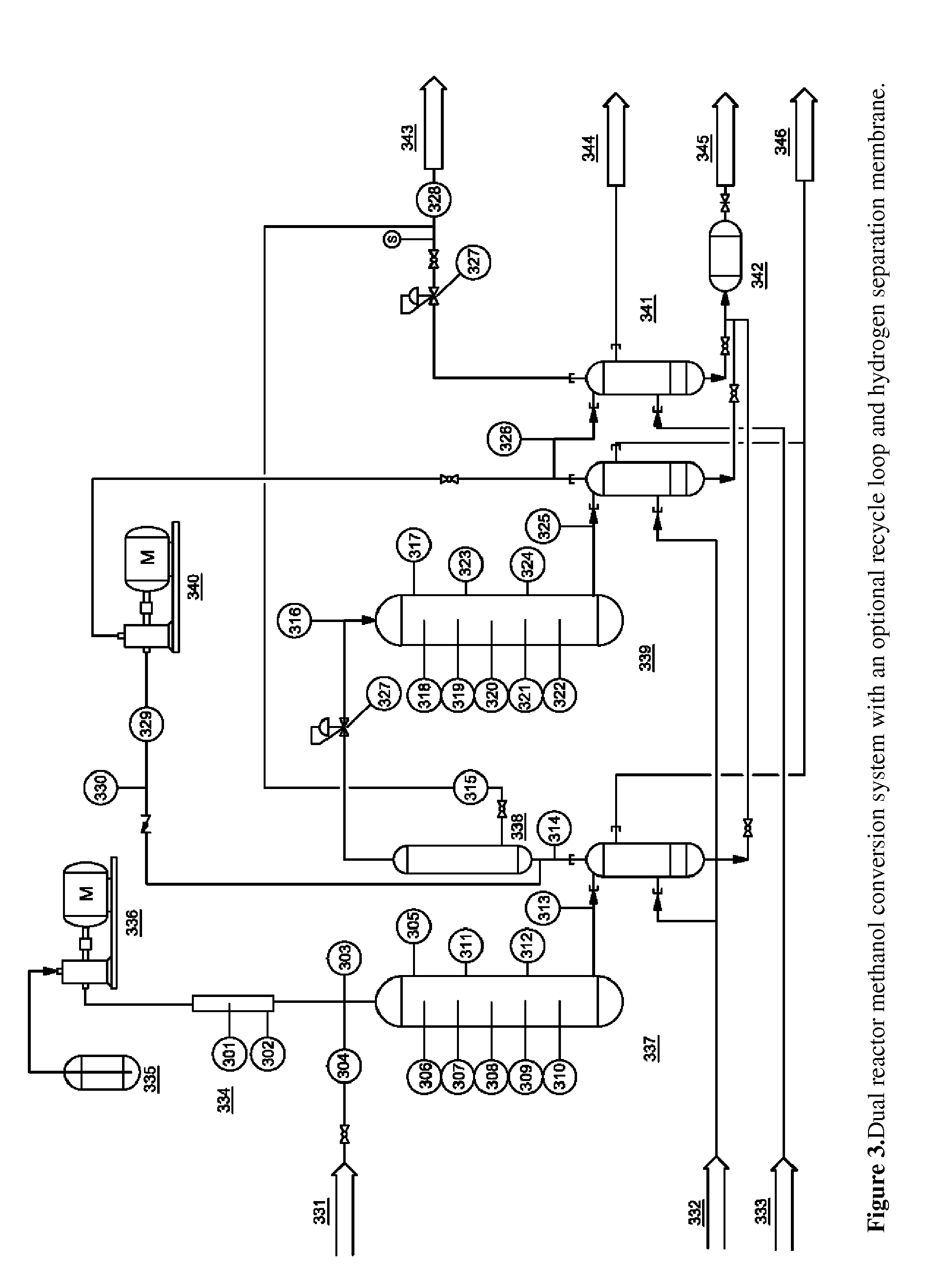Synthesis of Drop-in Liquid Fuels and Chemicals from Methanol, Ethanol or Syngas Using Mixed Catalysts
a technology of methanol and ethanol, which is applied in the direction of ether preparation, ether preparation, hydrocarbon oil treatment products, etc., can solve the problems of requiring both vehicle modifications and a new distribution infrastructure, requiring bulky and expensive fuel tanks, and complete changes to the refueling infrastructur
- Summary
- Abstract
- Description
- Claims
- Application Information
AI Technical Summary
Benefits of technology
Problems solved by technology
Method used
Image
Examples
experiment 1
[0076]The zeolite catalyst used in these examples was ZSM-5 in the acid form doped with 5 wt % Zn. Commercial HZSM-5 (provided by Tricat Inc., SiO2 / Al2O3=23.5) was doped with Zn(NO3)2 using the incipient wetness impregnation technique. The wetted catalyst was heated to 80° C. for 6 hours, dried at 120° C. for 6 hours and finally calcined at 600° C. for 6 hours. Gamma-alumina catalyst was obtained from a commercial source (Tricat Inc.) and used as received. The reactor system for this experiment, illustrated in FIG. 1, consisted of an ASA schedule 40 steel pipe reactor with a 10:1 form factor and 1.5 inch diameter, for an internal volume of approximately 0.5 L. Temperatures were measured by thermocouples running the length of the bed and measured from the center of the reactor. Pressure was monitored by a pressure transducer.
For this experiment the reactor was loaded with 25% (v / v) gamma-alumina and 75% Zn-ZSM-5. The catalysts were measured and homogenously mixed prior to loading the...
experiment 2
[0077]The same reactor system from EXPERIMENT 1 was used except a gradient composition mixed bed catalyst was used. The first third of the reactor was packed with homogenously mixed 75% gamma-alumina and 25% Zn-ZSM-5 (v / v) while the rest of the reactor was packed with 25% gamma-alumina and 75% Zn-ZSM-5. The temperature varied linearly from 200° C. at the inlet to 450° C. at the outlet, and the pressure was maintained at nominally atmospheric pressure. No inert diluent gas was used in these tests. The effects of other process variables are detailed in Table 2.
TABLE 2Sample #678910111213Methanol67676767134200267334GHSV (h−1)Approximate01240.90.60.50.4RecirculationRatioOrganic Liquid66.672.468.167.559.853.055.544.9Yield (%)
experiment 3
[0078]This experiment used the two reactor system as described in FIG. 2. Reactor 1 was a mixed-bed, gradient reactor with the first third consisting of 75% gamma-alumina and 25% Zn-ZSM-5 (v / v) while the rest of the reactor was packed with 25% gamma-alumina and 75% Zn-ZSM-5. Temperatures in the first reactor varied linearly from 200° C. at the inlet to 400° C. at the outlet. Reactor 2 was packed with Zn-ZSM-5 only and was held at nominally atmospheric pressure and 400° C. The pressure of the first reactor was varied as shown in Table 3. A hydrogen separation membrane was also included in between the reactors for some tests. Sample 17 included a recirculation loop that fed the product gas into the system immediately before the separation membrane.
TABLE 3Sample #14151617Methanol GHSV (h−1)267267281267Membrane UsednoyesyesyesReactor Pressure (psig)0308035Recirculation Rate0004.5Organic Liquid Yield (%)73.872.964.471.7Total Product Distribution (wt %)Water47.750.349.156.2H21.61.31.10.4C...
PUM
| Property | Measurement | Unit |
|---|---|---|
| atmospheric pressure | aaaaa | aaaaa |
| atmospheric pressure | aaaaa | aaaaa |
| pressure | aaaaa | aaaaa |
Abstract
Description
Claims
Application Information
 Login to View More
Login to View More - R&D
- Intellectual Property
- Life Sciences
- Materials
- Tech Scout
- Unparalleled Data Quality
- Higher Quality Content
- 60% Fewer Hallucinations
Browse by: Latest US Patents, China's latest patents, Technical Efficacy Thesaurus, Application Domain, Technology Topic, Popular Technical Reports.
© 2025 PatSnap. All rights reserved.Legal|Privacy policy|Modern Slavery Act Transparency Statement|Sitemap|About US| Contact US: help@patsnap.com



